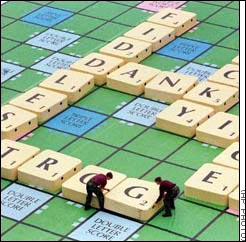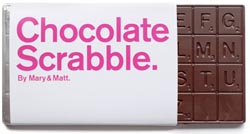
Do you like Scrabble and dominos?
No, let me rephrase.
Do you like the concept of Scrabble and dominos, but don't like the actual games? Would it be fair to say that Scrabble is extremely frustrating because of the limited number of words you can play, and dominos seems like a kid's game?
Well, that's because you haven't played Unscrabbleink and Grandma's Dominos yet.
Below the fold is the way to play these two great games.
Unscrabbleink
I once had a roommate who really liked Scrabble, so I started playing it with him. I hadn't played it in years.
 At the time, I was heavily into crossword puzzles, and only being able to use the 'legitimate' words in the crappy little Scrabble dictionary was very frustrating. Plus, with only one each of the five heavy scoring tiles (J, K, Q, X, Z), if someone got two or three of them and laid them down on a Triple score, the game was pretty much over. The game could get too lopsided, too quickly.
At the time, I was heavily into crossword puzzles, and only being able to use the 'legitimate' words in the crappy little Scrabble dictionary was very frustrating. Plus, with only one each of the five heavy scoring tiles (J, K, Q, X, Z), if someone got two or three of them and laid them down on a Triple score, the game was pretty much over. The game could get too lopsided, too quickly.
Clearly, something had to be done.
So I got hold of Hasbro, the manufacturer, and ordered two more blank tiles and an extra J, K, Q, X and Z. Their online order page is here.
In Unscrabbleink, you can use any word that might be found in a crossword puzzle. That would include proper names ("Elvis"), abbreviations ("NASA"), foreign words ("nyet"), locations in both English and the native language ("Rome", "Roma"), and anything else commonly found in crossword puzzles.
Because it was so contrary to standard Scrabble, almost like some demographic East-West thing, I adapted a Russian accent and called the game Unscrabbleink.
With four blank tiles and two-each of the big scorers, it's an absolute blast.
If you're into the 'challenge' part of the game, you'll need a minimum number of Google hits for the word to count. I use 100,000. If you lay down a word and you're challenged, look it up on Google. If it's under 100,000, you lose a turn. If it's over, the challenger does.
Another problem with the original game is that it needed more than seven letters in a hand, so in Unscrabbleink you draw nine tiles.
This is also fun to do with a computer Scrabble game, assuming it has the option to add new words to its dictionary. At first, you'll kick its butt with "Oz", "PDQ", "QED", etc, but at some point, as it gets smarter, it'll be you who's the one racing to catch up. Out of frustration at getting your ass whupped you'll eventually delete the program's custom dictionary and start over. At least (delicate cough), that's what I've heard some people do.
And imagine the fun of playing with a buddy and not telling him about the extra tiles. Both scenarios would be a riot:
If you suddenly play the second 'X', his eyes are going to pop out and he'll say, "Hey, there aren't two X's!" Very seriously look him in the eye and say, "Don't be silly — of course there are. You just never noticed before."
But if he suddenly draws the second 'X', he's going to be torn in two. Half of him will want to say, "Hey, this isn't right!", but the other half will be telling himself to shut up — and check out that Triple Word Score coming up!
If you like Scrabble — or rather, if you like the concept of Scrabble — you really owe it to yourself to dig up the seven extra tiles and give this a try. It's a ton of fun.
Grandma's Dominos
 As far as I'm concerned, regular dominos, where you can only play off the first double played, is right up there with watching paint dry. At least, after you've played Grandma's Dominos.
As far as I'm concerned, regular dominos, where you can only play off the first double played, is right up there with watching paint dry. At least, after you've played Grandma's Dominos.
I call it that because it reminds me of how we might have played it with Grandma when we were kids. It's a simpler, more natural game because you can play off any double. Young children would like that, and so will you.
Not to draw any comparisons, of course.
It makes for more scoring opportunities, makes the game much more challenging, and allows a lot more strategy when it comes to what to play. It makes it much more of an offensive-defensive game, in that you might defensively hold back a domino or two (sacrificing some points) to go out with, while going on the offensive by trying to make your opponent draw. But not too early or it'll give him a wealth of scoring opportunities. It's really a fun game, and it's kind of stunning that people (and the computer games) play it with only one 'spinner'.
A few rules:
— You initially draw 9 'bones', not 7. The first two you play usually don't account for very many points; they're just to get the track started. That leaves you with a full 7 bones to start 'working' the game.
— You score by making the ends come out to multiples of 5, getting 1 point for each multiple. If the ends total 20, that's 4 points. Whoever has the most points after someone makes it to 100 wins. Traditionally, points are kept on a Cribbage board. If you 'skunk' your opponent by going out before he's even 'made the turn' (at the 50-point mark on the Cribbage board), you get twice the payoff.
— Both ends of a double count until both sides have been closed off.
— The lead changes with each hand. You can lead with any domino, scores count.
— You draw from the boneyard until you can play; two bones remain untouched.
I consider this a two-player game. Three dilutes it too much and most of the strategy is lost. It's still a fun game, but not the same. If you're playing with three, start off with the usual seven bones, not nine.
With so many options to play, much of the strategy is baiting or forcing the other player into playing what you want. That is, a domino you can score upon. The ideal play is to make a big score and your opponent can't come back with a score because the necessary dominos have already been played or you've got them in your hot grubby mitts.
I'll bet that as soon as you play it this way, you'll wonder why you ever played it the other way. The bigger scores make everything much more tense and allow for some really great comebacks. If you've never particularly thought of dominos as a 'strategy' game before, give this a try with a smart opponent. It'll take you both a couple of games before you really 'get' the offensive-defensive balance. Then you'll see what I mean by "tense."


 Do you like Scrabble and dominos?
Do you like Scrabble and dominos?  At the time, I was heavily into crossword puzzles, and only being able to use the 'legitimate' words in the crappy little Scrabble dictionary was very frustrating. Plus, with only one each of the five heavy scoring tiles (J, K, Q, X, Z), if someone got two or three of them and laid them down on a Triple score, the game was pretty much over. The game could get too lopsided, too quickly.
At the time, I was heavily into crossword puzzles, and only being able to use the 'legitimate' words in the crappy little Scrabble dictionary was very frustrating. Plus, with only one each of the five heavy scoring tiles (J, K, Q, X, Z), if someone got two or three of them and laid them down on a Triple score, the game was pretty much over. The game could get too lopsided, too quickly. As far as I'm concerned, regular dominos, where you can only play off the first double played, is right up there with watching paint dry. At least, after you've played Grandma's Dominos.
As far as I'm concerned, regular dominos, where you can only play off the first double played, is right up there with watching paint dry. At least, after you've played Grandma's Dominos.